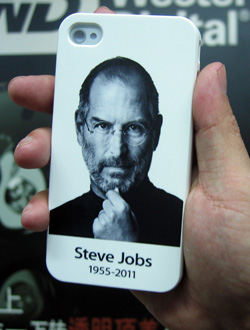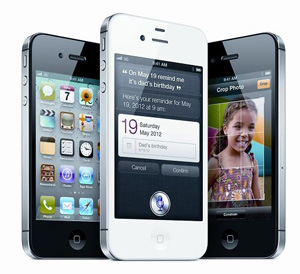While in the past few days many across the world have been mourning the loss of Steve Jobs, each remembering his achievements in their own way; it may ultimately prove to be the products launched by Apple, under his stewardship, which will eventually go on to steal back the limelight, just as Steve Jobs himself has done so many times before.
 |
| A vendor shows an iPhone 4 cover with an image of the late Apple founder Steve Jobs, on sale in Shenzhen, in southern China's Guangdong province . AFP |
Widely regarded as "beautiful," one of a multitude of adjectives used which result in similar sentiments; Apple's 'iProducts' are best described as aspirational. In fact most products are beyond the available means of most of the people in the world. So much so that Apple, initially a computer manufacturer, has now evolved into a marketing machine churning out the next cool high end gadget rather than its initial efforts to make computers accessible to ordinary people. An initial calling which had grouped Jobs with the likes of Edison and Ford in that they all created revolutionary products which changed the environment of their day.
In fact, because of Apple's steep price points (a basic iPod Shuffle retails online for US$ 49, an iPad costs US$ 499 and the Mac Mini desktop computer, sold without monitor, keyboard, mouse, etc., is priced at US$ 599), it is more than possible that many who are now honouring the life of Steve Jobs have had only very limited exposure to Apple. At least this would be the case for many Sri Lankans, as well as others from emerging and/or less developed economies. A case in point, Apple only has four stores in China and none in India, mostly ignoring what could be considered the main population centres in the world, in favour of high income centric cities.
As such, we have taken it upon ourselves to chart, below, an overview of the iconic Apple products launched under Jobs’ tenure at Apple, so those that may one day worship at this mantle of design, by shopping there, will know what Jobs has truly achieved...
The GUI-enabled Lisa and the more successful Macintosh
Founded by Steve Jobs, Steve Wozniak and Ronald Wayne in 1976, Apple initially sold computers requiring a lot of assembly to hobbyists via mail order. However, it was the launch of the Apple Lisa in 1983 and the Apple Macintosh in 1984 that proved most significant, not only for the company but also for society, as this marked the beginning of the personal computer industry. Thanks to Graphical User Interface (GUI) technology inspired by the Xerox Alto, which was included in both Apple products, users no longer had to be programmers but rather just used menus to execute functions. In turn, Apple's GUIs also later inspired Microsoft's Windows operating system, now the default operating system for almost all PCs.
While the Lisa proved to be a commercial flop, the Macintosh did much better, admittedly because of its exceptional marketing efforts. But, most importantly for Jobs, and unknown to all at the time, these products put him in the league of Edison and Ford. Also important to note, while not being demanded en masse, these products also paved the way for computers to be used in desktop publishing and graphics, the most common uses for personal computers today, whereas historically computers had been exclusively the domain of businesses.
Interestingly, the Macintosh also marked Jobs’ first, and only, early commercial success with Apple. Following a dispute with the board, he was sidelined and later resigned from the company. In 1985, he went on to found NeXT computer manufacturing. Also noteworthy, the Macintosh product line also spawned one of the first laptop computers in the form of the PowerBook in 1991.
The fall and rise of Apple
Following a long, and very visible, decline, Apple's resurgence only really kicked off in 1998, again led by Jobs who had regained management of the company the year before.
The next iconic product from the brand was the iMac. Designed by a team led by Jonathan Ive, later responsible for the iPod and iPhone, the iMac was a colourful all-in-one personal computer reminiscent of the Macintosh that sold 800,000 units over its first five months. Sales were undoubtedly spurred by the fact that its unique design was unlike anything seen before, at that time. This later evolved into Apple's winning combination of even more minimalistic designs and greater technologically advanced product, at higher prices, which were hallmarks of the new iMac and Mini Mac desktop computers, in 2005, and culminated in 2011's MacBook Air.
Three years later, in 2001, Apple did it again with the iPod portable digital audio player, a product which sold over 100 million units in just six years. At the same time, Apple further leveraged this platform with its online iTunes Store in 2003.
At the time, this was a revolutionary idea which allowed people to easily install or download iTunes software on their computer, either Mac or PC, and buy music online and "sync" it with their iPods. Later also the basis of the landmark App Store for iPhones, iPads, etc., another over US$ 1 billion source of revenue for Apple, the iTunes Store sold music downloads for $0.99 a song and went on to soon also dominate overall music sales, with over 5 billion songs downloaded by 2008, a span of time during which it also signed download agreements with every record label. An especially impressive feat considering this was the industry that had previously taken down file sharer Napster using aggressive patent litigation.
The next sea change for Apple was 2007's launch of the iPhone, an impeccably designed, fast and easy-to-use smart phone with a touch screen, a cool GUI and superior video/audio properties for which Apple was becoming renowned. Most telling of all was this product's launch being famously introduced by Steve Jobs announcing to the world that Apple was no longer a computer company but rather a mobile electronics company. iPhone sales numbers soon supported Jobs’ new vision and a little more than a year later Apple became the world's third largest mobile phone company and, eventually, the world leader in smart phone sales.
Just over a year later, in 2008, Apple's breakthrough App Store went online, spawning a whole new generation of killer applications or "apps" for the iPhone, and later the iPad, the latter which shared the iPhone's operating system and so being compatible. Within the short span of a month, the store started achieving daily average sales of US$ 1 million. Also, the store sold 60 million applications over its first month.
In 2010, Apple again re-invented itself again by extending its product line into the fledgling tablet PC market. The iPad was a hybrid which heavily borrowed from the graphics, the operating system, the touch screen, etc., essentially what users loved about the iPhone, while essentially just making the screen bigger, to 1/.1 inches.
This was pitched as a new category of product, something between your iPhone and your iMac Pro laptop, significantly more portable than a laptop and used to read electronic books, play lightweight mobile games like Angry Birds, etc. and, with its built i Wi Fi, browse the Internet, all without lugging around a bulky laptop.
Most important to its success, its access to the App Store's treasure trove of content numbering thousands of books, games, etc., much of which is available free of charge or, at worst, at a nominal fee. The iPad sold more than 300,000 units on the day of its launch and reached sales of 500,000 by the end of its launch week. The winning combination of easy-to-use, great graphics and virtually unlimited content proved to be unbeatable as, even more than a year after its launch, it has maintained its dominance of the tablet market, even despite a number of so-called iPad killers which have failed to impress.
Most recently, in 2011, an anticipated launch of the iPhone 5 (the iPhone 4 was launched in 2010) never came to fruition despite a media speculation frenzy. However, launched instead, the iPhone 4S came out with significantly superior technical specifications, including dual A5 core, Siri voice recognition, an iOS update, and better cameras, etc. And, despite initial disappointment at there not being a new iPhone version, the most recent pre-order numbers announced by Apple point to one million units being ordered online within the first 24 hours of its launch announcement, a number which shattered Apple's previous record of 600,000 units pre-ordered which was for the iPhone 4 in 2010.
The end of an era
Many analysts are currently conjecturing that, with US$ 75 billion in cash in its balance sheet and virtual market dominance with the App Store, iPad and iTunes, and significant worldwide smartphone penetration with iPhones, Apple, even without Steve Jobs, remains the competitor to beat in the short and even medium term. A factor further underscored by recent media claims that a dying Steve Jobs spent some of the precious time he had left nailing down the next four years of Apple's product launches.
However, the question for the long run is: Can Apple maintain its momentum in the long run without Steve Jobs? After all, it didn't do quite so well after firing him in 1985.
| The new iPhone 5? |
 Not really. Apple dissappointed technophiles recently when, instead of launching a much-anticipated iPhone 5, the company unveiled an updated version of the iPhone 4. This is a product initially launched way back in 2010, even though the newly-minted iPhone 4S is vastly superior to its predecessor, now featuring 800 MHz dual A5 cores, an updated iOS 5 and better specifications, including a 8MP camera, 1080p HD recording, superior connectivity, and a trendy voice recognition application called Siri. Not really. Apple dissappointed technophiles recently when, instead of launching a much-anticipated iPhone 5, the company unveiled an updated version of the iPhone 4. This is a product initially launched way back in 2010, even though the newly-minted iPhone 4S is vastly superior to its predecessor, now featuring 800 MHz dual A5 cores, an updated iOS 5 and better specifications, including a 8MP camera, 1080p HD recording, superior connectivity, and a trendy voice recognition application called Siri.
However, at least according to one seasoned tech commentator, this was a right move for new Apple chief Tim Cook as the much improved upgrade is capable of offering all the benefits of a new iPhone release without out many of the production delays that these launches have faced in the past. Thus is a situation which seems to hold true as Apple last week announced that it had received one million pre-orders with the first 24-hours of the iPhone 4S's launch, a new record for pre-orders that greatly overshadowed the previous one for the iPhone 4 in 2010 where 600,000 pre-orders were received within 24-hours. The iPhone 4S debuted at Apple Retail Stores last Friday. |
|


 Not really. Apple dissappointed technophiles recently when, instead of launching a much-anticipated iPhone 5, the company unveiled an updated version of the iPhone 4. This is a product initially launched way back in 2010, even though the newly-minted iPhone 4S is vastly superior to its predecessor, now featuring 800 MHz dual A5 cores, an updated iOS 5 and better specifications, including a 8MP camera, 1080p HD recording, superior connectivity, and a trendy voice recognition application called Siri.
Not really. Apple dissappointed technophiles recently when, instead of launching a much-anticipated iPhone 5, the company unveiled an updated version of the iPhone 4. This is a product initially launched way back in 2010, even though the newly-minted iPhone 4S is vastly superior to its predecessor, now featuring 800 MHz dual A5 cores, an updated iOS 5 and better specifications, including a 8MP camera, 1080p HD recording, superior connectivity, and a trendy voice recognition application called Siri. 